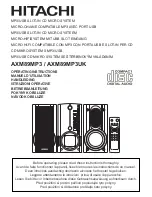
NetWave DirectView Broadcast Console Operations & Technical Manual
Revision A
2 - Installation
Harris Broadcast
2-3
PR&E
ground wire, DC power cable, and any Link and LAN cables can then be connected. Again, leave all excess
cable dropped down into the cabinet or into the cable tray.
Power Supply Placement
Two types of power supplies are used with NetWave consoles. Each power supply has a single 48-volt DC
output cable with a keyed and locking connector. Each supply uses a detachable IEC AC input cable with a
USA-type plug. The AC connector, or the IEC cord, must be changed for overseas operation. Both supplies
can operate from 90 to 240 VAC on 50 or 60 Hz power.
●
The PRE99-1206 in-line supply comes standard on NetWave-8 and NetWave-16 consoles. This supply
has a captive six-foot DC cable, so it must be located near the right rear corner of the console. It is
typically set on the cable tray or mounted within the cabinet. The supply can be tie-wrapped to a vertical
wall to save space. This supply becomes warm under normal use. Since it uses free air space for
ventilation, it must never be covered or closely enclosed.
●
The PRE99-1205 Universal 48-volt Supply comes standard on the NetWave-24. It requires 2 RU of rack
space within the console cabinetry, typically located below and to the left or right of the console. This
supply is also used on VistaMax card frames and RMXdigital consoles. A detachable 15-foot DC cable
connects the supply to the NetWave console.
Either supply must be installed such that the keyed 48-volt supply cable is not under any tension when
routed through the cabinet to the NetWave power connector. The 48-volt cable locks into a keyed power
connector on the right rear corner of the NetWave chassis, as viewed from the board operator position.
If you use the optional PRE90-1995 Power Coupler (optional) to add a redundant power supply for on-air
consoles, the main and redundant power supplies plug into a Y-cable, which then plugs into the console. The
Power Coupler Y-cable typically hangs down through the cutout so that the cable is below the countertop.
Note: Do not defeat the IEC power cord “U” safety ground in any way, as this action may
create a potentially dangerous condition to the operator.
Grounding and Shielding
You should terminate a technical ground wire for the console in a crimped ring tongue terminal suitable for a
#8 stud which connects to the NetWave chassis using a #8 screw in a threaded insert (Figure 2-3).
Figure 2-3. Technical Ground Connection Point, NetWave Chassis (right rear view)
When all system components share a common ground potential, using isolated ground AC outlets tied
individually back to the main technical ground, the audio cable shields can connect at the console and
peripheral ends, or you can use unshielded balanced wiring to simplify installation.
If isolated ground AC outlets are not used throughout, connect the cable shields at the console end only. Do
not connect the shields at the peripheral device end. Ensure the peripheral devices connect to a clean
ground through their power cords or through separate ground wires to the facility’s technical ground.
Note: Grounding – The Power Supply chassis connects to the AC mains safety or “U” ground wire.
Tie a 14-16 AWG ground wire to
this threaded insert using a ring
tongue fastener and a #8 screw.
















































